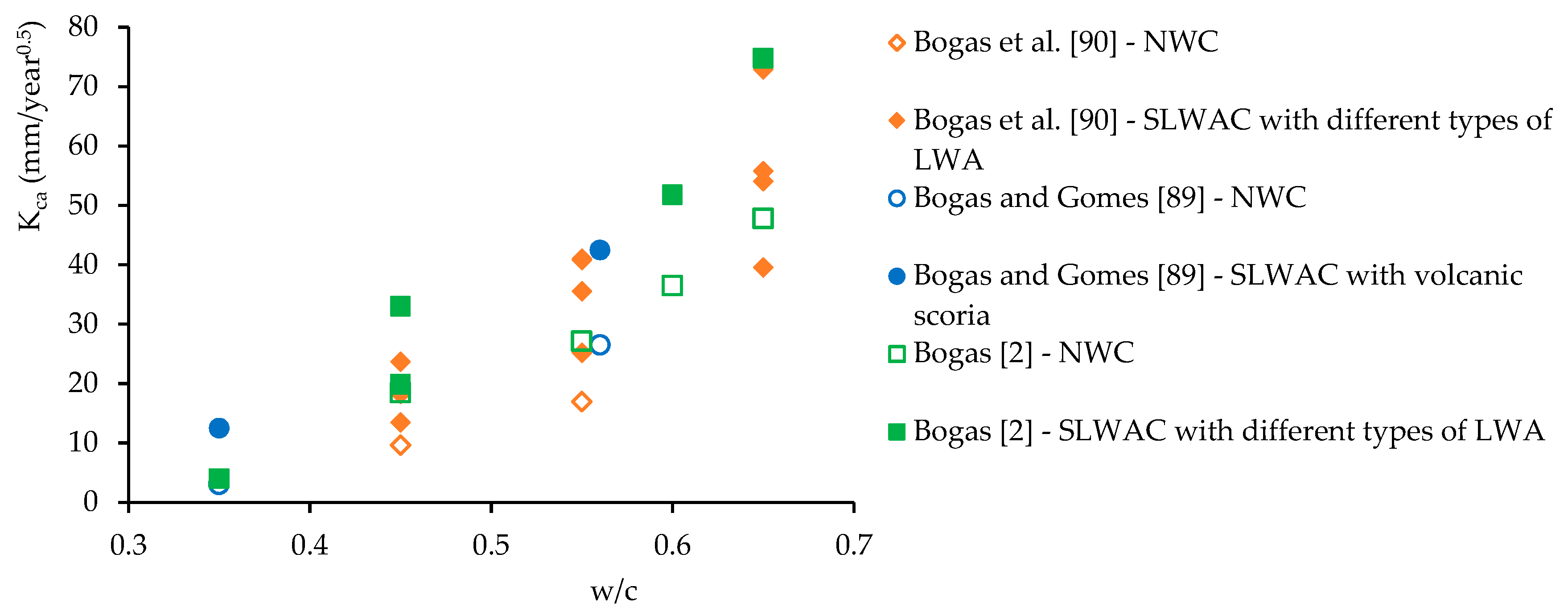A Review on the Carbonation and Chloride Penetration Resistance of Structural Lightweight Aggregate Concrete
Abstract
1. Introduction
2. Transport Properties
2.1. Permeability
2.2. Water Permeability
2.3. Gas Permeability
2.4. Capillary Absorption
3. Carbonation
3.1. Influence of the Type of Aggregate
3.2. Biphasic Carbonation Model
3.3. Influence of the Type of Binder
3.4. Carbonation Resistance in Real Environment
4. Chloride Ingress
4.1. Influence of the Type of Aggregate
4.2. Influence of the Type of Binder
4.3. Chloride Ingress in Marine Environment
5. Service Life Prediction for Carbonation and Chloride-Induced Corrosion
6. Influence of Cracking on SLWAC Durability
7. Conclusions
Author Contributions
Funding
Acknowledgments
Conflicts of Interest
References
- Holm, T.; Bremner, T. State-of-the-Art Report on High-Strength, High Durability Structural Low-Density Concrete for Applications in Severe Marine Environments; ERDC/SL TR-00-3; US Army Corps of Engineers. Structural Laboratory: Washington, DC, USA, 2000. [Google Scholar]
- Bogas, J. Characterization of Structural Lightweight Expanded Clay Aggregate Concrete. Ph.D. Thesis, Instituto Superior Técnico, Universidade de Lisboa, Lisboa, Portugal, 2011. (In Portuguese). [Google Scholar]
- Bogas, J.; Gomes, M.; Real, S. Chloride migration resistance of structural lightweight concrete. In Proceedings of the International Conference on Civil and Environmental Engineering (ICOCEE), Cappadocia, Turkey, 20–23 May 2015. [Google Scholar]
- Real, S.; Bogas, J. Permeabilidade ao oxigénio de betões estruturais de agregados leves. In Proceedings of the Construção2018—Reabilitar e Construir de Forma Sustentável, FEUP, Porto, Portugal, 21–23 November 2018. [Google Scholar]
- Bogas, J.; Ferrer, B.; Pontes, J.; Real, S. Compressive strength and structural efficiency of structural lightweight aggregate concrete—Throughout a compressive strength biphasic behavior. In Proceedings of the Third International Conference On Advances in Civil, Structural and Construction Engineering, CSCE 2015, Rome, Italy, 10–11 December 2015. [Google Scholar]
- Real, S.; Bogas, J.A.; Pontes, J. Chloride migration in structural lightweight aggregate concrete produced with different binders. Constr. Build. Mater. 2015, 98, 425–436. [Google Scholar] [CrossRef]
- Bogas, J.; Gomes, A. Non-steady-state accelerated chloride penetration resistance of structural lightweight aggregate concrete. Cem. Concr. Compos. 2015, 60, 111–122. [Google Scholar] [CrossRef]
- Bremner, T. Lightweight concrete. In Developments in the Formulation and Reinforcement of Concrete—A Volume in Woodhead Publishing Series in Civil Engineering; Woodhead Publishing: Cambridge, UK, 2008. [Google Scholar]
- Chandra, S.; Berntsson, L. Lightweight Aggregate Concrete: Science, Technology and Applications; Noyes Publications/William Andrew Publishing: Norwich, NY, USA, 2002. [Google Scholar]
- Sintsov, G. Experience and forecasts concerning application of reinforced concrete for sea vessels and floating structures. In Concrete Sea Structures: Proceedings of the FIP Symposium, Tbilisi, September, 1972; Maxwell-Cook, P.V., Ed.; Fédération Internationale de la Précontrainte (FIP): London, UK, 1973. [Google Scholar]
- Raithby, K.D.; Lydon, F.D. A Review of the International Use of Lightweight Concrete in Highway Bridges, Tech Rpt. 20 Monograph. August 1981.
- Holm, T. Performance of Structural Lightweight Concrete in a Marine Environment; ACI SP-65; Malhotra, V.M., Ed.; American Concrete Institute: Detroit, MI, USA, 1980. [Google Scholar]
- Vaysburd, A. Durability of lightweight concrete bridge in severe environments. Concr. Int. 1996, 18, 33–38. [Google Scholar]
- Mays, G.; Barnes, R. The performance of lightweight aggregate concrete structures in service. Struct. Eng. 1991, 69, 351–360. [Google Scholar]
- Thienel, K.; Schmidt-Dohl, F.; Feldrappe, V. In-situ tests on existing LWAC structures. In Proceedings of the Second International Symposium on Structural Lightweight Aggregate Concrete, Kristiansand, Norway, 18–22 June 2000. [Google Scholar]
- Helland, S. Performance of lightweight aggregate concrete in marine environment. In Proceedings of the Theodore Bremner Symposium on High-performance Lightweight Concrete as a Part of the Sixth CANMET/ACI International Conference on Durability of Concrete, Thessaloniki, Greece, 1–7 June 2003. [Google Scholar]
- Fidjestol, P. Lightweight concrete in the marine environment. In High Performance Structural Lightweight Concrete; ACI, SP-218, Ries, J.P., Holm, T.A., Eds.; American Concrete Institute: Farmington Hills, MI, USA, 2002. [Google Scholar]
- EN 1992-1-1. Eurocode 2: Design of Concrete Concrete Structures—Part 1-1: General Rules and Rules for Buildings; European Committee for standardization (CEN): Brussels, Belgium, 2004; p. 225. [Google Scholar]
- BS 5400-4. Steel, Concrete and Composite Bridges. Part 4: Code of Practice for Design of Concrete Bridges; British Standards Institution (BSI): London, UK, 1990; p. 92. [Google Scholar]
- BS 8110-1. Structural Use of Concrete. Part 1: Code of Practice for Design and Construction; British Standards Institution (BSI): London, UK, 1997; p. 168. [Google Scholar]
- FIB 34. Model Code for Service Life Design; Bulletin 34; Prepared by Task Group 5.6: Model code for service life design of concrete structures; Fédération Internationale du Béton (FIB): Lausanne, Switzerland, 2006. [Google Scholar]
- EN 206. Concrete. Specification, Performance, Production and CONFORMITy; European Committee for standardization (CEN): Brussels, Belgium, 2013. [Google Scholar]
- Mehta, P.; Monteiro, P. Concrete: Microestructure, Properties and Materials, 3rd ed.; Mc Graw Hill: New York, NY, USA, 2006. [Google Scholar]
- Zhang, M.; Gjørv, O. Characteristics of lightweight aggregates for high strenght LWA concrete. In Materialutvikling Hoyfast Betong; SINTEF Report. 2.2. STF70 A92022; SINTEF: Trondheim, Norway, 1989. [Google Scholar]
- Con, E.L. LWAC material properties—State-of-the-art. In Economic Design and Construction with Light Weight Aggregate Concrete, European Union—Brite EuRam III; document BE96-3942/R2; Delft University of Technology: Delft, The Netherlands, 1998. [Google Scholar]
- Bertolini, L.; Elsener, B.; Pedeferri, P.; Polder, R. Corrosion of Steel in Concrete—Prevention, Diagnosis, Repair; Wiley-VCH: New York, NY, USA, 2004. [Google Scholar]
- Garboczi, E. Microstructure and transport properties of concrete. In Rilem Report 12—Performance Criteria for Concrete Durability; Kropp, J., Hilsdorf, H., Eds.; State of the art report by Rilem technical committee TC 116-PCD, Performance of concrete as a criterion of its durability; E&FN Spon: London, UK, 1995. [Google Scholar]
- Bogas, J.; Gomes, A. Compressive behavior and failure modes of structural lightweight aggregate concrete—Characterization and strength prediction. Mater. Des. 2013, 46, 832–841. [Google Scholar] [CrossRef]
- Bogas, J.; Gomes, M.; Real, S. Capillary absorption of structural lightweight aggregate concrete. Mater. Struct. 2015, 48, 2869–2883. [Google Scholar] [CrossRef]
- Thomas, M.; Bremner, T. Performance of lightweight aggregate concrete containing slag after 25 years in a harsh marine environment. Cem. Concr. Res. 2012, 42, 358–364. [Google Scholar] [CrossRef]
- Zhang, M.; Gjørv, O. Penetration of cement paste into lightweight aggregate. Cem. Concr. Res. 1992, 22, 47–55. [Google Scholar] [CrossRef]
- Zhang, M.; Gjørv, O. Microstructure of the interfacial zone between lightweight aggregate and cement paste. Cem. Concr. Res. 1990, 20, 610–618. [Google Scholar] [CrossRef]
- Huang, L.; Yu, L.; Zhang, H.; Yang, Z. Composition and microstructure of 50-year lightweight aggregate concrete (LWAC) from Nanjing Yangtze River bridge (NYRB ). Constr. Build. Mater. 2019, 216, 390–404. [Google Scholar] [CrossRef]
- Real, S.; Bogas, J.A. Oxygen permeability of structural lightweight aggregate concrete. Constr. Build. Mater. 2017, 137, 21–34. [Google Scholar] [CrossRef]
- Liu, X.; Chia, K.S.; Zhang, M.H. Water absorption, permeability, and resistance to chloride-ion penetration of lightweight aggregate concrete. Constr. Build. Mater. 2011, 25, 335–343. [Google Scholar] [CrossRef]
- Bentz, D.; Halleck, P.; Grader, A.; Roberts, J. Water movement during internal curing: Direct observation using X-ray microtomography. Concr. Int. 2006, 28, 39–45. [Google Scholar]
- FIP. FIP Manual of Lightweight Aggregate Concrete, 2nd ed.; FIP, Surrey University Press: Glasgow, UK, 1983. [Google Scholar]
- Zhang, M.H.; Gjørv, O. Permeability of high strength lightweight concrete. ACI Mater. J. 1991, 88, 463–469. [Google Scholar]
- Vaysburd, A. Durability of lightweight concrete and its connections with the composition of concrete, design and construction methods. In Structural Lightweight Aggregate Concrete Performance, SP-136; American Concrete Institute: Farmington Hills, MI, USA, 1992. [Google Scholar]
- Newman, J. Properties of structural lightweight aggregate concrete. In Structural Lightweight Aggregate Concrete; Clarke, J.L., Ed.; Chapman & Hall: Glasgow, UK, 1993. [Google Scholar]
- Bai, Y.; Ibrahim, R.; Basheer, P. Properties of Lightweight Concrete Manufactured with Fly Ash, Furnace Bottom Ash, and Lytag. In Proceedings of the International Workshop on Sustainable Development and Concrete Technology, Beijing, China, 20–21 May 2004. [Google Scholar]
- Bogas, J.; Gomes, A. A simple mix design method for structural lightweight aggregate concrete. Mater. Struct. 2013, 46, 1919–1932. [Google Scholar] [CrossRef]
- Bogas, J.; Gomes, A.; Pereira, M. Self-compacting lightweight concrete produced with expanded clay aggregate. Constr. Build. Mater. 2012, 35, 1013–1022. [Google Scholar] [CrossRef]
- Bardhan-Roy, B. Lightweight aggregate concrete in UK. In Proceedings of the International Symposium on Structural Lightweight Aggregate Concrete, Sandefjord, Norway, 20–24 June 1995; Holand, I., Hammer, T.A., Fluge, F., Eds.; Norwegian Concrete Association: Oslo, Norway, 1995. [Google Scholar]
- Khorin, N.K. The Durability of Lightweight Concrete Structural Members; USSR: Kuibyshev, Russia, 1973. (In Russian) [Google Scholar]
- Nishi, S.; Oshio, A.; Sone, T.; Shirokuni, S. Watertightness of concrete against sea-water. J. Cent. Res. Lab 1980, 32, 40–53. [Google Scholar]
- Hammer, T.; Smeplass, S. The influence of lightweight aggregate properties on material properties of the concrete. In Proceedings of the International Symposium Structural Lightweight Aggregate Concrete, Sandefjord, Norway, 20–24 June 1995. [Google Scholar]
- Ionescu, I.; Ispas, T. Properties and operating behaviour of some light concrete structures. In Proceedings of the Second International Symposium on Structural Lightweight Aggregate Concrete, Kristiansand, Norway, 18–22 June 2000. [Google Scholar]
- Chia, K.; Zhang, M. Water permeability and chloride penetrability of high-strength lightweight aggregate concrete. Cem. Concr. Res. 2002, 32, 639–645. [Google Scholar] [CrossRef]
- Liu, X.; Chia, K.S.; Zhang, M.H. Development of lightweight concrete with high resistance to water and chloride-ion penetration. Cem. Concr. Compos. 2010, 32, 757–766. [Google Scholar] [CrossRef]
- Kockal, N.U.; Ozturan, T. Durability of lightweight concretes with lightweight fly ash aggregates. Constr. Build. Mater. 2011, 25, 1430–1438. [Google Scholar] [CrossRef]
- Keeton, P. Permeability Studies of Reinforced Thin-Shell Concrete; Technical report R692 YF51.001,01.001; Naval engineering laboratory: Port Hueneme, CA, USA, 1970. [Google Scholar]
- Bamforth, P. The relationship between permeability coefficients for concrete obtained using liquid and gas. Mag. Concr. Res. 1987, 39, 3–11. [Google Scholar] [CrossRef]
- Bremner, T.; Holm, T.; McInerney, J. Influence of compressive stress on the permeability of concrete. In Structural Lightweight Aggregate Concrete Performance; ACI SP-136; Holm, T.A., Vaysburd, A.M., Eds.; American Concrete Institute: Farmington Hills, MI, USA, 1992. [Google Scholar]
- Smeplass, S.; Havdahl, J. Submerged Tube—Permeability And Rebar Corrosion; SINTEF report STF 65 A90004; SINTEF: Trondheim, Norway, 1990. [Google Scholar]
- ACI 213R. Guide for Structural Lightweight-Aggregate Concrete; American Concrete Institute (ACI): Farmington Hills, MI, USA, 2003. [Google Scholar]
- Schulze, W.; Gunzler, J. Corrosion protection of the reinforcement in lightweight concrete. In Proceedings of the 1st International Congress on Lightweight Concrete London, London, UK, 27–29 May 1968; C&CA: Kuala Lumpur, Malaysia, 1968. [Google Scholar]
- Short, A.; Kinniburgh, W. Lightweight Concrete, 3rd ed.; Applied Science Publishers: London, UK, 1978. [Google Scholar]
- Bologna, G.; Levi, F. Constructions en Béton Léger; Cembureau—The European cement association: Paris, France, 1974. [Google Scholar]
- Powers, T.; Copeland, L.; Hayes, J.; Mann, H. Permeability of portland cement paste. ACI J. Proc. 1954, 51, 285–298. [Google Scholar]
- Hossain, K.; Lachemi, M. Mixture design, strength, durability, and fire resistance of lightweight pumice concrete. ACI Mater. J. 2007, 104, 449–457. [Google Scholar]
- Teo, D.; Mannan, M.; Kurian, V. Durability of lightweight OPS concrete under different curing conditions. Mater. Struct. 2010, 43. [Google Scholar] [CrossRef]
- Chia, K.; Zhang, M. A comparative study of water permeability and chloride penetration in lightweight and normalweight aggregate concrete. In Proceedings of the Theodore Bremner Symposium on High-Performance Lightweight Concrete as a Part of the Sixth CANMET/ACI International Conference on Durability of Concrete, Thessaloniki, Greece, 1–7 June 2003. [Google Scholar]
- Haque, N.; Al-Khaiat, H. Strength and durability of lightweight concrete in hot marine exposure conditions. Mater. Struct. 1999, 32, 533–538. [Google Scholar] [CrossRef]
- Nyame, B. Permeability of normal and lightweight mortars. Mag. Concr. Res. 1985, 37, 4–8. [Google Scholar] [CrossRef]
- Abbas, A.; Carcasses, M.; Ollivier, J.P. Gas permeability of concrete in relation to its degree of saturation. Mater. Struct. 1999, 32, 3–8. [Google Scholar] [CrossRef]
- Lee, M.J.; Lee, M.G.; Chen, J.U.; Tia, M. Strength and freeze-thaw testing of lightweight aggregate concretes. Adv. Mater. Res. 2013, 723, 507–514. [Google Scholar] [CrossRef]
- Sugiyama, T.; Bremmer, T.W.; Holm, T.A. Effect of stress on gas permeability in concrete. ACI Mater. J. 1996, 93, 443–450. [Google Scholar]
- Ben-Othman, B.; Buenfeld, N. Oxygen permeability of structural lightweight aggregate concrete. In Protection of Concrete; Dhir, R.K., Green, J.W., Eds.; E & FN Spon: London, UK, 1990. [Google Scholar]
- Güneyisi, E.; Gesoǧlu, M.; Pürsünlü, Ö.; Mermerdaş, K. Durability aspect of concretes composed of cold bonded and sintered fly ash lightweight aggregates. Compos. Part B Eng. 2013, 53, 258–266. [Google Scholar] [CrossRef]
- Lydon, F. Effect of coarse aggregate and water cement ratio on intrinsic permeability of concrete subject to drying. Cem. Concr. Res. 1995, 25, 1737–1746. [Google Scholar] [CrossRef]
- Lydon, F.; Mahawish, A. Tests of the permeability of concrete to nitrogen gas. Constr. Build. Mater. 1991, 5, 8–17. [Google Scholar] [CrossRef]
- Gesoǧlu, M.; Güneyisi, E.; Özturan, T.; Öz, H.Ö.; Asaad, D.S. Permeation characteristics of self compacting concrete made with partially substitution of natural aggregates with rounded lightweight aggregates. Constr. Build. Mater. 2014, 59. [Google Scholar] [CrossRef]
- CRIC. Les propriétés des bétons légers de structure. In Centre National de Recherches Scientifiques et Techniques Pour L’Industrie Cimentiere; CRIC: Brussels, Belgium, 1977. [Google Scholar]
- Smeplass, S. Drying of LWAC. In Proceedings of the International Symposium Structural Lightweight Aggregate Concrete, Sandefjord, Norway, 20–24 June 2000. [Google Scholar]
- Al-Khaiat, H.; Haque, N. Strength and durability of lightweight and normal weight concrete. J. Mater. Civ. Eng. 1999, 11, 231–235. [Google Scholar] [CrossRef]
- Holm, T.; Ooi, O.; Bremner, T. Moisture dynamics in lightweight aggregate and concrete. In Proceedings of the Theodore Bremner Symposium on High-Performance Lightweight Concrete as a Part of the Sixth CANMET/ACI International Conference on Durability of Concrete, Thessalonikē, Greece, 1–7 June 2003. [Google Scholar]
- Vieira, M.G. High-Performance Concrete with Lightweight Aggregates. Durability and Microstructure. Master’s Thesis, Laboratório Nacional de Engenharia Civil, Lisbon, Portugal, 2003. (In Portuguese). [Google Scholar]
- Hammer, T.; Hansen, E. Water permeability of LWAC. In Proceedings of the Second International Symposium on Structural Lightweight Aggregate Concrete, Kristiansand, Norway, 18–22 June 2000. [Google Scholar]
- Henkensiefken, R.; Castro, J.; Bentz, D.; Nantung, T.; Weiss, J. Water absorption in internally cured mortar made with water-filled lightweight aggregate. Cem. Concr. Res. 2009, 39, 883–892. [Google Scholar] [CrossRef]
- Castro, J.; Keiser, L.; Golias, M.; Weiss, J. Absorption and desorption properties of fine lightweight aggregate for application to internally cured concrete mixtures. Cem. Concr. Compos. 2011, 33, 1001–1008. [Google Scholar] [CrossRef]
- Punkki, J.; Gjørv, O. Effect of aggregate absorption on properties of high-strength lightweight concrete. In Proceedings of the International Symposium Structural Lightweight Aggregate Concrete, Sandefjord, Norway, 20–24 June 1995. [Google Scholar]
- Bamforth, P.; Nolan, É. UK high strength LWAC in construction. In Proceedings of the Second International Symposium on Structural Lightweight Aggregate Concrete, Kristiansand, Norway, 18–22 June 2000. [Google Scholar]
- Gesoǧlu, M.; Güneyisi, E.; Ali, B.; Mermerdaş, K. Strength and transport properties of steam cured and water-cured lightweight aggregate concretes. Constr. Build. Mater. 2013, 49, 417–424. [Google Scholar] [CrossRef]
- Mo, K.H.; Alengaram, U.J.; Jumaat, M.Z.; Liu, M.Y.J.; Lim, J. Assessing some durability properties of sustainable lightweight oil palm shell concrete incorporating slag and manufactured sand. J. Clean. Prod. 2016, 112, 763–770. [Google Scholar] [CrossRef]
- Real, S. Durability and Thermal Performance of Structural Lightweight Aggregate Concrete Produced with Different Types of Cementitious Materials. Ph.D. Thesis, Instituto Superior Técnico, Universidade de Lisboa, Lisbon, Portugal, 2019. (In Portuguese). [Google Scholar]
- Brown, J.; Beeby, A. Exposure site carbonation depth measurements. In BCA Report for Building Research Establishment; Building Research Establishment: Garston, UK, 1992. [Google Scholar]
- Gündüz, L.; Uğur, I. The effects of different fine and coarse pumice aggregate/cement ratios on the structural concrete properties without using any admixtures. Cem. Concr. Res. 2005, 35, 1859–1864. [Google Scholar] [CrossRef]
- Bogas, J.; Gomes, T. Mechanical and durability behaviour of structural lightweight concrete produced with volcanic scoria. Arab. J. Sci. Eng. 2015, 40, 705–717. [Google Scholar] [CrossRef]
- Bogas, J.; Real, S.; Ferrer, B. Biphasic carbonation behaviour of structural lightweight aggregate concrete produced with different types of binder. Cem. Concr. Compos. 2016, 71, 110–121. [Google Scholar] [CrossRef]
- Zhao, Y.; Gao, J.; Chen, F.; Liu, C.; Chen, X. Utilization of waste clay bricks as coarse and fine aggregates for the preparation of lightweight aggregate concrete. J. Clean. Prod. 2018, 201, 706–715. [Google Scholar] [CrossRef]
- CEB-FIP. Lightweight Aggregate Concrete—CEB-FIP Manual of Design and Technology. In Comite Euro-international du béton (CEB) and Fédération internationale de la précontrainte (FIP); The Construction Press: London, UK, 1977. [Google Scholar]
- Swamy, R.; Jiang, E. Pore structure and carbonation of lightweight concrete after 10 years exposure. In Structural Lightweight Aggregate Concrete Performance; Holm, T.A., Vaysburd, A.M., Eds.; American Concrete Institute: Farmington Hills, MI, USA, 1992; ACI SP-136. [Google Scholar]
- Lo, T.Y.; Tang, W.C.; Nadeem, A. Comparison of carbonation of lightweight concrete with normal weight concrete at similar strength levels. Constr. Build. Mater. 2008, 22, 1648–1655. [Google Scholar] [CrossRef]
- Lo, T.Y.; Nadeem, A.; Tang, W.C.P.; Yu, P.C. The effect of high temperature curing on the strength and carbonation of pozzolanic structural lightweight concretes. Constr. Build. Mater. 2009, 23, 1306–1310. [Google Scholar] [CrossRef]
- Haque, M.N.; Al-Khaiat, H.; Kayali, O. Strength and durability of lightweight concrete. Cem. Concr. Compos. 2004, 26, 307–314. [Google Scholar] [CrossRef]
- Bremner, T.; Holm, T.; Stepanova, V. Lightweight concrete—A proven material for two millennia. In Proceedings of the Advances in Cement and Concrete, Durham, NH, USA, 24–29 July 1994; Sarkar, S.L., Grutzeck, M.W., Eds.; University of New Hampshire: Durham, NH, USA, 1994. [Google Scholar]
- Weber, S.; Reinhardt, H. Modeling the internal curing of high-strenght concrete using lightweight aggregates. In Proceedings of the Theodore Bremner Symposium on High-performance Lightweight Concrete as a Part of the Sixth CANMET/ACI International Conference on Durability of Concrete, Thessalonikē, Greece, 1–7 June 2003. [Google Scholar]
- Gao, Y.; Cheng, L.; Gao, Z.; Guo, S. Effects of different mineral admixtures on carbonation resistance of lightweight aggregate concrete. Constr. Build. Mater. 2013, 43, 506–510. [Google Scholar] [CrossRef]
- Hubertová, M.; Hela, R. Durability of lightweight expanded clay aggregate concrete. Concerte and concrete structures 2013 conference. Procedia Eng. 2013, 65, 2–6. [Google Scholar] [CrossRef]
- Ferrer, B.; Alexandre Bogas, J.; Real, S. Service life of structural lightweight aggregate concrete under carbonation-induced corrosion. Constr. Build. Mater. 2016, 120, 161–171. [Google Scholar] [CrossRef]
- Holm, T.; Bremner, T.; Vaysburd, A. Carbonation of marine structural lightweight concretes. In Performance of Concrete in Marine Environment, Second International Conference; American Concrete Institute: Farmington Hills, MI, USA, 1988; ACI SP-109. [Google Scholar]
- Holm, T.; Bremner, T.; Newman, J. Lightweight aggregate concrete subjected to severe weathering. ACI Concr. Int. 1984, 6, 49–54. [Google Scholar]
- Bandyopadhyay, A.; Swamy, R. Durability of steel embedded instructural lightweight concrete. Mater. Struct. 1975, 8, 203–210. [Google Scholar]
- Salem, N.; Ltifi, M.; Hassis, H. Characterisation of lightweight concrete of Tunisian expanded clay: Mechanical and durability study. Eur. J. Environ. Civ. Eng. 2016. [Google Scholar] [CrossRef]
- Ohuchi, T.; Hara, M.; Kubota, N.; Kobayashi, A.; Yokayama, M. Some long-term observation results of artficial lightweight aggregate concrete for structural use in Japan. In Proceedings of the International Symposium on Long-term Observation of Concrete Structures, Budapest, Hungary, 17–20 September 1984. [Google Scholar]
- Mircea, D.; Loani, A.; Filip, M.; Pepenar, I. Long-term durability of reinforced and prestressed elements in aggressive environments. ACI Mater. J. 1994, 91, 135–140. [Google Scholar]
- Kayali, O.; Zhu, B. Chloride induced reinforcement corrosion in lightweight aggregate high-strength fly ash concrete. Constr. Build. Mater. 2005, 19, 327–336. [Google Scholar] [CrossRef]
- Hwang, C.L.; Tran, V.U. Engineering and durability properties of self-consolidating concrete incorporating foamed lightweight aggregate. J. Mater. Civ. Eng. 2016. [Google Scholar] [CrossRef]
- Youm, K.S.; Moon, J.; Cho, J.Y.; Kim, J.J. Experimental study on strength and durability of lightweight aggregate concrete containing silica fume. Constr. Build. Mater. 2016, 114, 517–527. [Google Scholar] [CrossRef]
- Liu, X.; Du, H.; Zhang, M.H. A model to estimate the durability performance of both normal and light-weight concrete. Constr. Build. Mater. 2015, 80, 255–261. [Google Scholar] [CrossRef]
- NT Build 492. Concrete, Mortar and Cement Based Repair Materials: Chloride Migration Coefficient from Non-Steady State Migration Experiments; Nordtest Method: Helsinki, Finland, 1999. [Google Scholar]
- ASTM C1202. Standard Test Method for Electrical Indication of Concrete’s Ability to Resist Chloride Ion Penetration; American Society for Testing & Materials (ASTM): West Conshohocken, PL, USA, 2009; p. 7. [Google Scholar]
- Gautefall, O.; Maage, M. High-Strength Concrete, SP4 Materials Design, Report 4.8 Chloride Penetration of HCS: Permeability, Diffusivity and Water Conveyance; SINTEF Report STF 70 A92136; SINTEF: Trondheim, Norway, 1992. [Google Scholar]
- Havdahl, J.; Hammer, T.; Justness, H.; Smeplass, S. LWA Concrete for Floaters, SP5 Durability, Report 5.1 Rebar Corrosion and Frost Resistance; SINTEF report STF 70 A93042; SINTEF: Trondheim, Norway, 1993. [Google Scholar]
- Güneyisi, E.; Gesoğlu, M.; Booya, E.; Mermerdaş, K. Strength and permeability properties of self-compacting concrete with cold bonded fly ash lightweight aggregate. Constr. Build. Mater. 2015, 74, 17–24. [Google Scholar] [CrossRef]
- Thomas, M.D.A. Chloride diffusion in high-performance lightweight aggregate concrete. In Proceedings of the Theodore Bremner Symposium on High-Performance Lightweight Concrete as a Part of the Sixth CANMET/ACI International Conference on Durability of Concrete, Thessalonikē, Greece, 1–7 June 2003. [Google Scholar]
- EuroLightCon R3. Chloride penetration into concrete with lightweight aggregates. In European Union—Brite EuRam III; Delft University of Technology: Delft, The Netherlands, 1999; BE96-3942/R3. [Google Scholar]
- Wang, F.; Hu, S.; Ding, Q.; Peng, Y. Influence of mineral admixtures on the permeability of lightweight aggregate concrete. J. Wuhan Univ. of Technol. Mater. Sci. Ed. 2005, 20, 115–118. [Google Scholar]
- Raithby, K.; Lydon, F. Lightweight concrete in highway bridges. Int. J. Cem. Compos. LIghtweight Concr. 1981, 3, 133–146. [Google Scholar] [CrossRef]
- Polder, R.B.; De Rooij, M.R.; De Vries, H.; Gulikers, J. Observed Chloride Penetration in Eastern Scheldt Storm Surge Barrier, The Netherlands, after 20 Years in North Sea Environment. In Workshop: Risk Based Maintenance of Structures; TU Delft: Delft, The Netherlands, 21 January 2003. [Google Scholar]
- Guthrie, W.; Waters, T.; Reese, G. Comparison of moisture content and electrical conductivity of lightweight and normal-weight concrete bridge decks: Instrumentation and monitoring. J. Cold Reg. Eng. 2015. [Google Scholar] [CrossRef]
- Moffatt, E.; Thomas, M.; Fahim, A. Performance of high-volume fly ash concrete in marine environment. Cem. Concr. Res. 2017, 102, 127–135. [Google Scholar] [CrossRef]
- Moffatt, E.; Thomas, M. Performance of 25-year-old silica fume and fly ash lightweight concrete blocks in a harsh marine environment. Cem. Concr. Res. 2018, 113, 65–73. [Google Scholar] [CrossRef]
- Real, S.; Bogas, J. Chloride ingress into structural lightweight aggregate concrete in real marine environment. Mar. Struct. 2018, 61, 170–187. [Google Scholar] [CrossRef]
- Helland, S.; Selmer, A. Lightweight Aggregate Concrete in Norwegian Bridges; Expanded Shale, Clay and Slate Institute Public: Salt Lake City, UT, USA, 2000; #4700.10. [Google Scholar]
- Maage, M.; Helland, S.; Carlsen, J. Service life prediction of LWA concrete in chloride environment. In Proceedings of the International Symposium Structural Lightweight Aggregate Concrete, Sandefjord, Norway, 20–24 June 1995. [Google Scholar]
- Helgesen; Hakon, K. Lightweight aggregate concrete in Norway. In Proceedings of the International Symposium Structural Lightweight Aggregate Concrete, Sandefjord, Norway, 20–24 June 1995. [Google Scholar]
- Osborne, G. The durability of lightweight aggregate concretes after 10 years in marine and acid water environments. In Proceedings of the International Symposium Structural Lightweight Aggregate Concrete, Sandefjord, Norway, 20–24 June 1995. [Google Scholar]
- Al-Khaiat, H.; Haque, N. Chloride and sulphate concentration in concrete exposed to marine conditions. In Proceedings of the 27th Conference on Our World in Concrete & Structures, Singapore, 29–30 August 2002. [Google Scholar]
- Gjørv, O.; Tan, K.; Zhang, M. Diffusivity of chlorides from seawater into high-strength lightweight concrete. ACI Mater. J. 1994, 91, 447–452. [Google Scholar]
- Neville, A. Properties of Concrete, 4th ed.; Standards updated to 2002; Pearson Education Limited: Essex, UK, 2004; reprinted. [Google Scholar]
- Justnes, H. A review of chloride binding in cementitious systems. Nord. Concr. Res. 1998, 21, 48–63. [Google Scholar]
- Dinakar, P.; Babu, K.G.; Santhanam, M. Durability properties of high volume fly ash self compacting concretes. Cem. Concr. Compos. 2008, 30, 880–886. [Google Scholar] [CrossRef]
- Alexander, M.; Thomas, M. Service life prediction and performance testing—Current developments and practical applications. Cem. Concr. Res. 2015, 78, 155–164. [Google Scholar] [CrossRef]
- E 464. Concrete. Prescriptive Methodology for a Design Working Life of 50 Years under the Environmental Exposure; LNEC specification: Lisboa, Portugal, 2007. (In Portuguese) [Google Scholar]
- E 465. Concrete. Methodology for Estimating the Concrete Performance Properties Allowing to Comply with the Design Working Life of the Reinforced or Prestressed Concrete Structures under the Environmental Exposures XC and XS; LNEC specification: Lisboa, Portugal, 2007. (In Portuguese) [Google Scholar]
- Real, S.; Bogas, J.A.; Ferrer, B. Service life of reinforced structural lightweight aggregate concrete under chloride-induced corrosion. Mater. Struct. 2017, 50. [Google Scholar] [CrossRef]
- Duracrete R15. Duracrete—General guidelines for durability design and redesign. In The European Union—Brite EuRam III. Probabilistic Performance Based Durability Design of Concrete Structures; Document BE95-1347/R15; TU Delft: Delft, The Netherlands, 2000. [Google Scholar]
- Duracrete R17. Duracrete—Final technical report. In The European Union—Brite EuRam III. Probabilistic Performance based Durability Design of Concrete Structures; Document BE95-1347/R17; CUR: Gouda, The Netherlands, 2000. [Google Scholar]
- Gérard, B.; Marchand, J. Influence of cracking on the diffusion properties of cement-based materials Part I: Influence of continuous cracks on the steady-state regime. Cem. Concr. Res. 2000, 30, 37–43. [Google Scholar] [CrossRef]
- De Schutter, G. Quantification of the influence of cracks in concrete structures on carbonation and chloride penetration. Mag. Concr. Res. 1999, 6, 427–435. [Google Scholar] [CrossRef]
- Jang, S.; Kim, B.; Oh, B. Effect of crack width on chloride diffusion coefficients of concrete by steady-state migration tests. Cem. Concr. Res. 2011, 41, 9–19. [Google Scholar] [CrossRef]
- Shin, K.; Bae, W.; Choi, S.; Woo, M.; Lee, K. Parameters influencing water permeability coefficient of cracked concrete specimens. Constr. Build. Mater. 2017, 151, 907–915. [Google Scholar] [CrossRef]
- EuroLightCon R13. Large-scale chloride penetration test on LWAC-beams exposed to thermal and hygral cycles. In European Union—Brite EuRam III; TU Delft: Delft, The Netherlands, 2000; BE96-3942/R13. [Google Scholar]
- Bogas, J.A.; Carriço, A.; Pontes, J. Influence of cracking on the capillary absorption and carbonation of structural lightweight aggregate concrete. Cem. Concr. Compos. 2019, 104, 103382. [Google Scholar] [CrossRef]

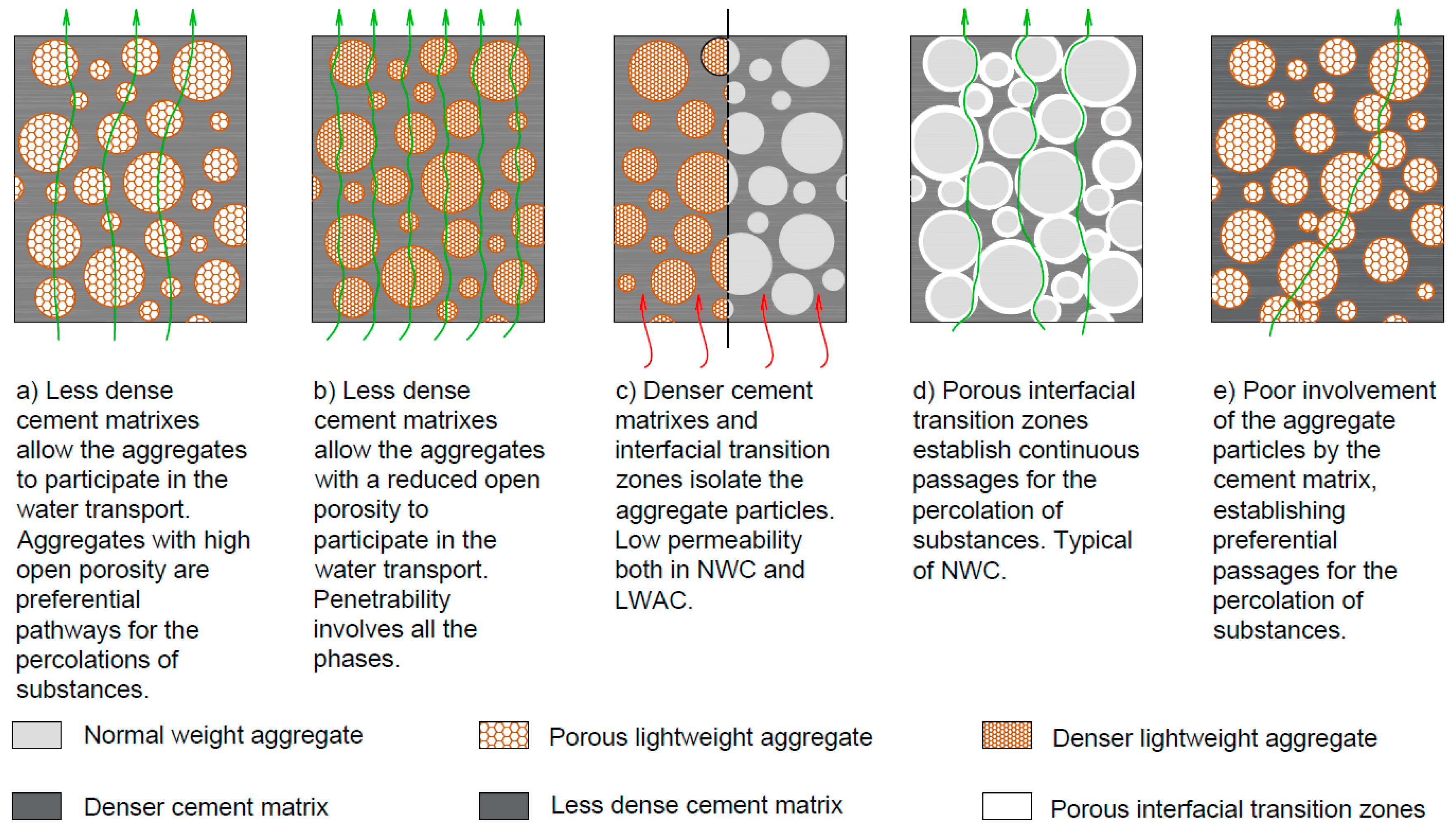

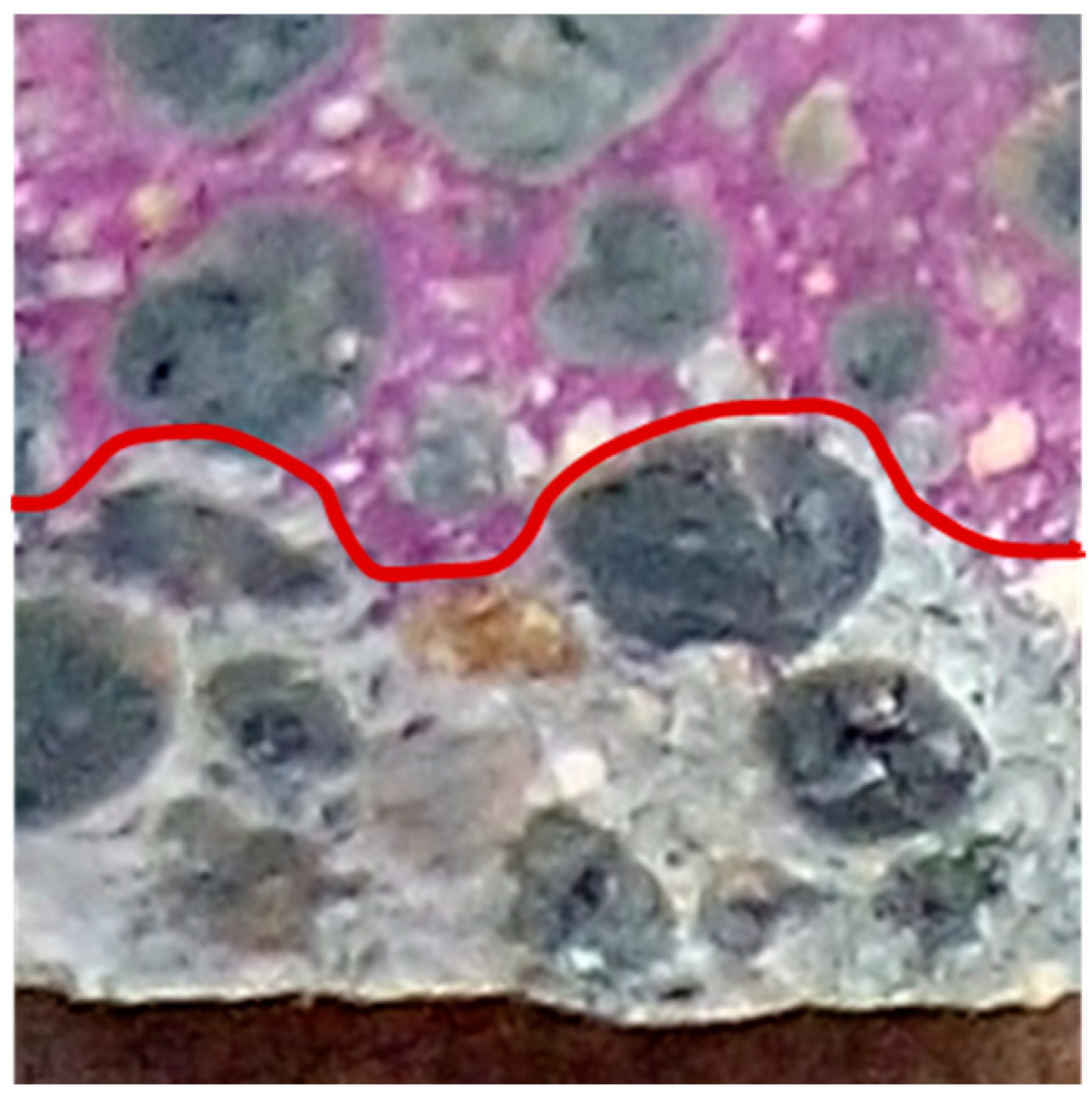
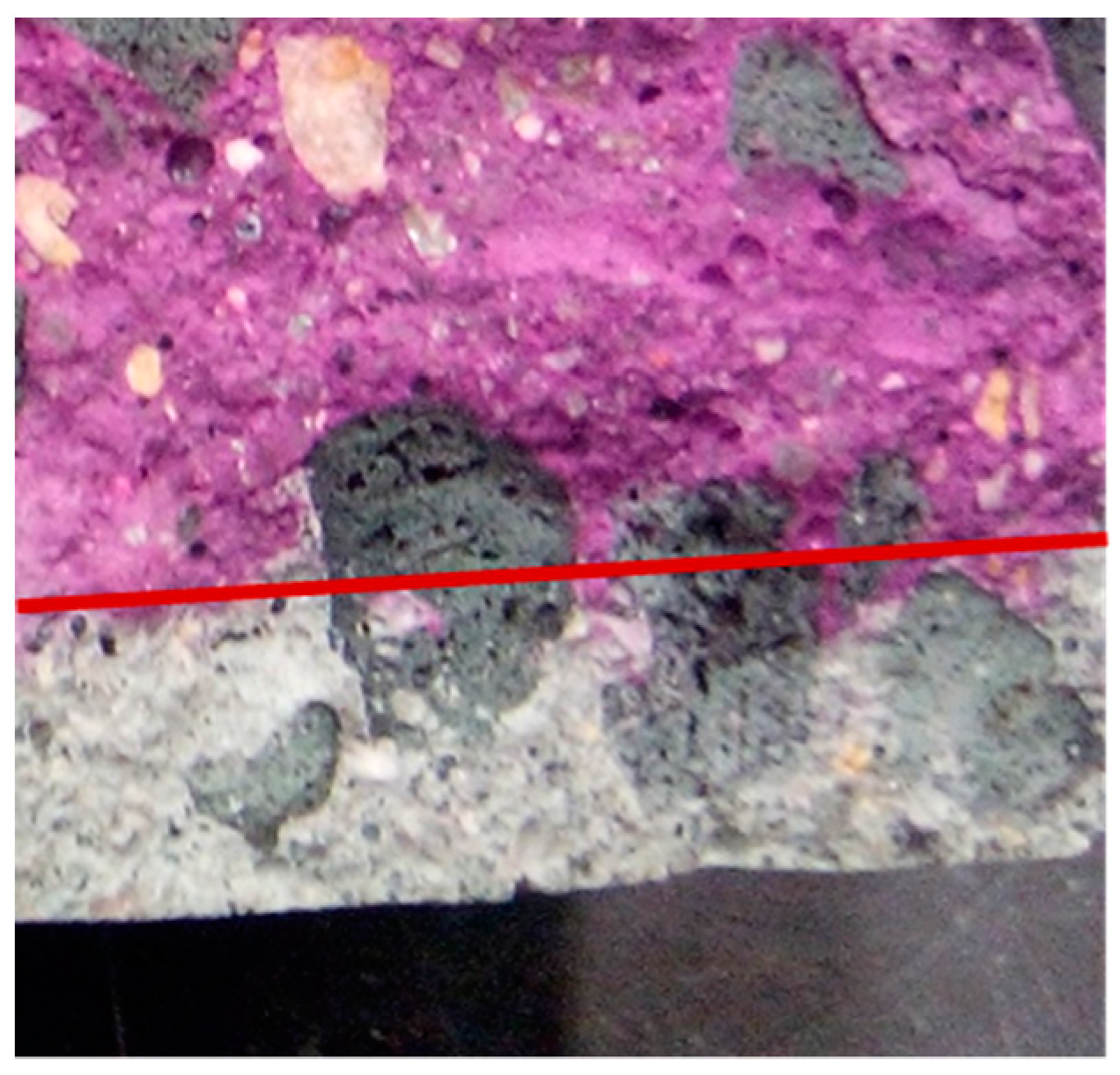
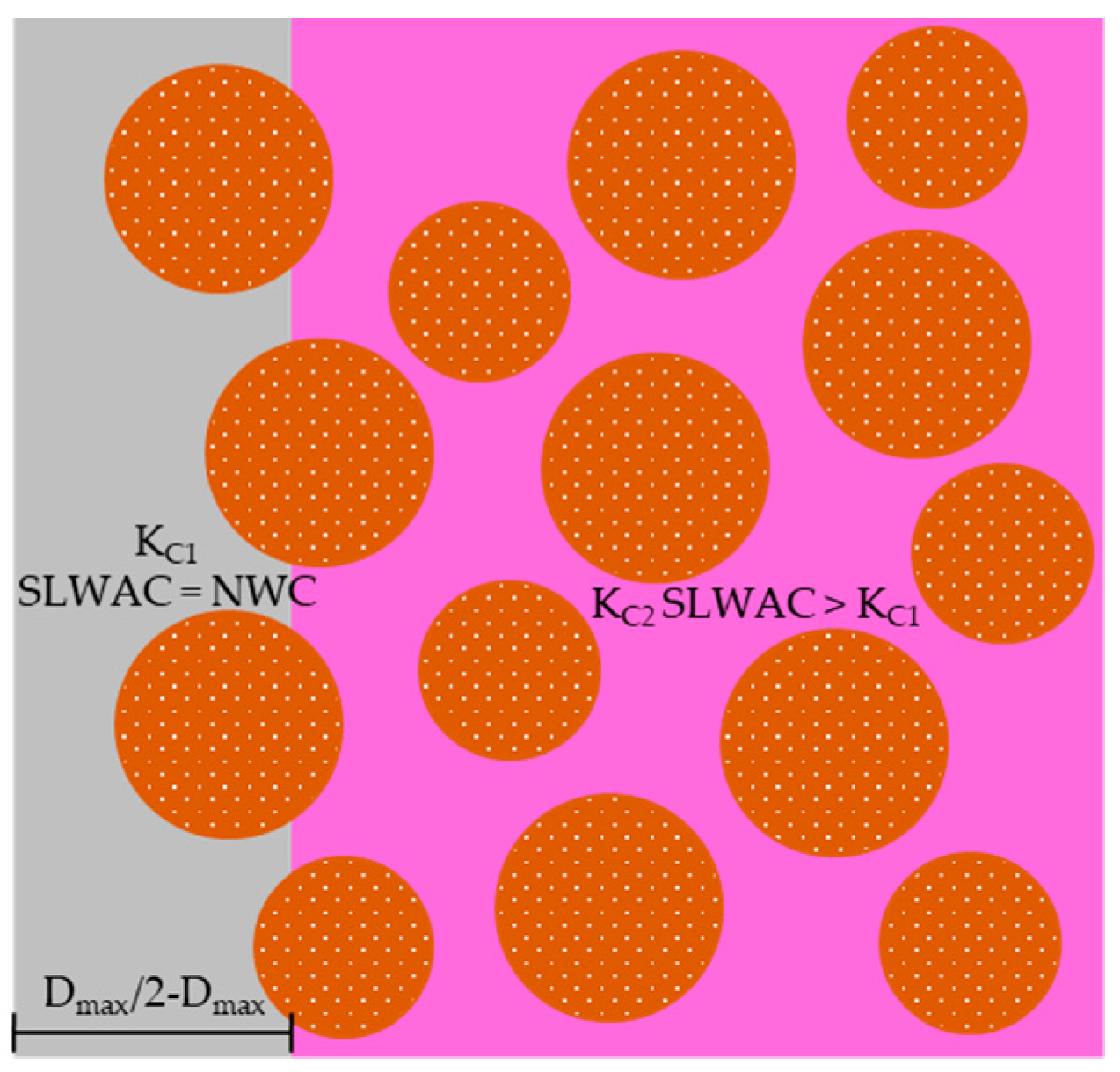

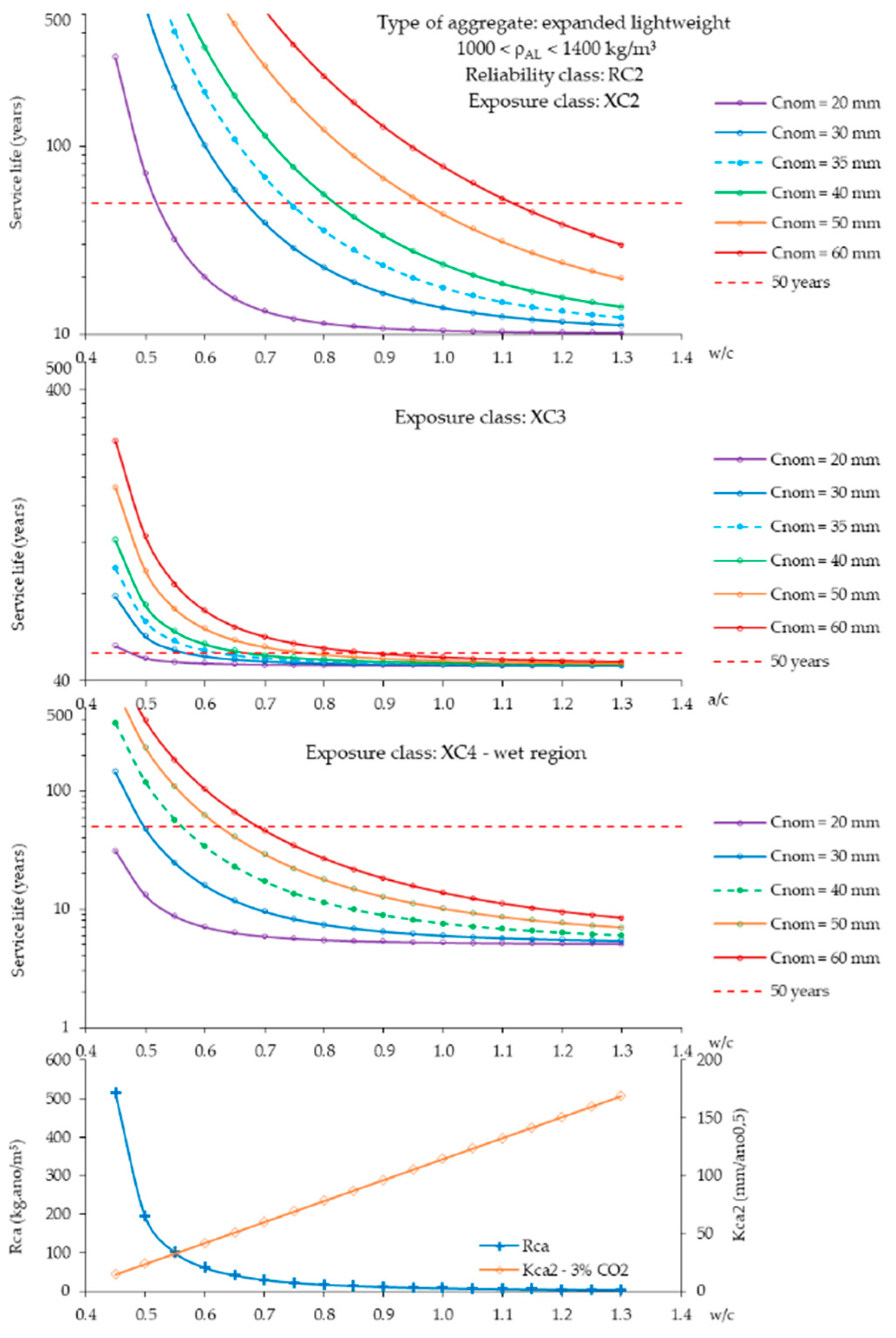
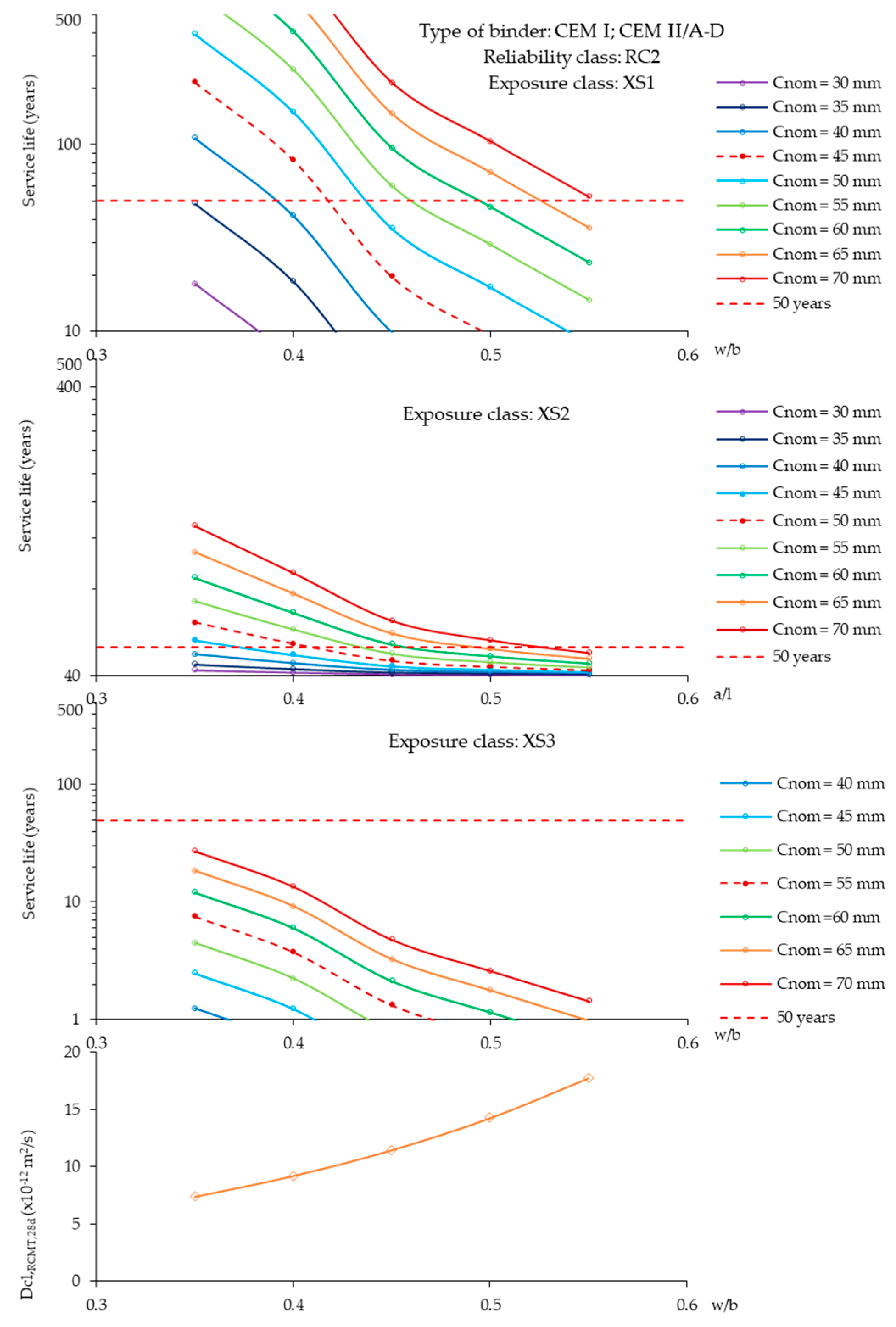
| Type of Aggregate | Aggregate Density Class | Kca1 (mm/year0.5) a,b | Kca2 (mm/year0.5) b | w/c Validity Range |
|---|---|---|---|---|
| Expanded LWA | <1000 kg/m3 | 136.7w/c-54.4 (for w/c > 0.45, disregard Kca1) | 220.8w/c-81.1 | 0.45–0.93 |
| >1000 kg/m3 and <1400 kg/m3 | 181.9w/c-67.4 | 0.45–1.30 | ||
| >1400 kg/m3 | 128.0w/c-43.1 | 0.45–1.30 | ||
| Sintered FA LWA | >1300 kg/m3 | 159.2w/c-50.3 | 0.45–0.93 |
| Reference | Exposure Conditions | Description | SLWAC Characteristics | Exposure Period (years) | Carbonation Depth (mm) | |
|---|---|---|---|---|---|---|
| Holm et al. [102] | XC4 | Main deck | of concrete ships built during World War II in Chesapeake Bay at Cape Charles, Virginia | >50 | 1 | |
| XC4 | Exposed wing walls | 1–2 | ||||
| XC4 | Hull and bulkheads | 0 | ||||
| Holm and Bremner [1] | XC4 | Top | of the bridge deck of Chesapeake Bay Bridge | 35 | 2–8 | |
| XC3 | Underside | 2–13 | ||||
| XC4 | Deck surface of the Interchange Bridge at Coxsackie | 15 | 5–10 | |||
| Ohuchi et al. [106] | XC4 | Japanese bridges and viaducts | Compressive strengths of 23–26 MPa | 19 | 13–16 | |
| Bandyopadhyay and Swamy [104] | SLWAC with expanded shale LWA, exposed to an industrial environment | w/c of 0.53 | 2 | 1 | ||
| Mays and Barnes [14] | 6 concrete structures in the United Kingdom | 20 | 6–25 | |||
| Short and Kinniburgh [58] | 3 | 2.5 | ||||
| Bogas [2] | XC4 | in port facilities in Setúbal, Portugal | w/b of 0.35 and 0.45 | 2 | 0–2 | |
| Real [86] | XC3 | in Grilo tunel in Lisbon, Portugal | w/b of 0.55 and 0.65 types of binder: 6–9% SF, 15–30% FA and 15–30% LF | 3 | 8–27 | |
| XC3 | on top DECivil building, in Instituto Superior Técnico, in Lisbon, Portugal | 6–28 | ||||
| XC4 | 4–21 | |||||
| XC4/XS1 | Cascais marina, Portugal | 2.5 | 5–28 | |||
| Normative Document | Parameter | Exposure Conditions | ||||||
|---|---|---|---|---|---|---|---|---|
| Carbonation | Chlorides from Sea Water | |||||||
| XC1 | XC2 | XC3 | XC4 | XS1 | XS2 | XS3 | ||
| EN 206 [22] | Maximum w/c | 0.65 | 0.6 | 0.55 | 0.5 | 0.5 | 0.45 | 0.45 |
| Min. strength class | C20/25 | C25/30 | C30/37 | C30/37 | C30/37 | C35/45 | C35/45 | |
| Minimum cement content (kg/m3) | 260 | 280 | 280 | 300 | 300 | 320 | 340 | |
| EN 1992-1-1 [18] | Minimum cover (mm) | 15 b | 25 b | 25 b | 30 b | 35 b | 40 b | 45 b |
| E 464 [136] | Maximum w/c | 0.65 | 0.65 | 0.55–0.60 a | 0.55–0.60 a | 0.45–0.55 a | 0.45–0.55 a | 0.40–0.45 a |
| Minimum strength class | C25/30 LC25/28 | C25/30 LC25/28 | C30/37 LC30/33 | C30/37 LC30/33 | C30/37-C40/50 a LC30/33-LC40/44 a | C30/37-C40/50 a LC30/33-LC40/44 a | C35/45-C50/60 a LC35/38-LC50/55 a | |
| Minimum cement content (kg/m3) | 240–260 a | 240–260 a | 280–300 a | 280–300 a | 320–360 a | 320–360 a | 340–380 a | |
| Type of Aggregate | Density of LWA (kg/m3) | Exposure Class | |||
|---|---|---|---|---|---|
| XC1 (cnom = 25 mm) | XC2 (cnom = 35 mm) | XC3 (cnom = 35 mm) | XC4 (cnom = 40 mm) | ||
| Expanded LWA | <1000 | w/c > 0.65 | w/c > 0.65 | w/c > 0.55 | w/c > 0.50 |
| >1000 and <1400 | w/c > 0.70 | w/c > 0.70 | w/c > 0.60 | w/c > 0.55 | |
| >1400 | w/c > 0.85 | w/c > 0.85 | w/c > 0.65 | w/c > 0.60 | |
| Sintered FA LWA | >1300 | w/c > 0.70 | w/c > 0.70 | w/c > 0.60 | w/c > 0.50 |
| Type of Aggregate | Density of LWA (kg/m3) | Exposure Class | ||
|---|---|---|---|---|
| XC2 | XC3 | XC4-RH | ||
| Δcmin (mm) | ||||
| Expanded LWA | <1000 | 18 | 16 | 24 |
| >1000 and <1400 | 11 | 9 | 14 | |
| >1400 | 4 | 2 | 5 | |
| Sintered FA LWA | >1300 | 9 | 9 | 16 |
| Type of Aggregate | Exposure Class | ||
|---|---|---|---|
| XS1 (cnom = 45 mm) | XS2 (cnom = 50 mm) | XS3 (cnom = 55 mm) | |
| Expanded LWA and NWA | w/c > 0.45 | w/c > 0.40 | w/c > 0.30 |
| Sintered FA LWA | w/c > 0.40 | w/c > 0.35 | w/c > 0.30 |
© 2019 by the authors. Licensee MDPI, Basel, Switzerland. This article is an open access article distributed under the terms and conditions of the Creative Commons Attribution (CC BY) license (http://creativecommons.org/licenses/by/4.0/).
Share and Cite
Bogas, J.A.; Real, S. A Review on the Carbonation and Chloride Penetration Resistance of Structural Lightweight Aggregate Concrete. Materials 2019, 12, 3456. https://doi.org/10.3390/ma12203456
Bogas JA, Real S. A Review on the Carbonation and Chloride Penetration Resistance of Structural Lightweight Aggregate Concrete. Materials. 2019; 12(20):3456. https://doi.org/10.3390/ma12203456
Chicago/Turabian StyleBogas, José Alexandre, and Sofia Real. 2019. "A Review on the Carbonation and Chloride Penetration Resistance of Structural Lightweight Aggregate Concrete" Materials 12, no. 20: 3456. https://doi.org/10.3390/ma12203456
APA StyleBogas, J. A., & Real, S. (2019). A Review on the Carbonation and Chloride Penetration Resistance of Structural Lightweight Aggregate Concrete. Materials, 12(20), 3456. https://doi.org/10.3390/ma12203456




